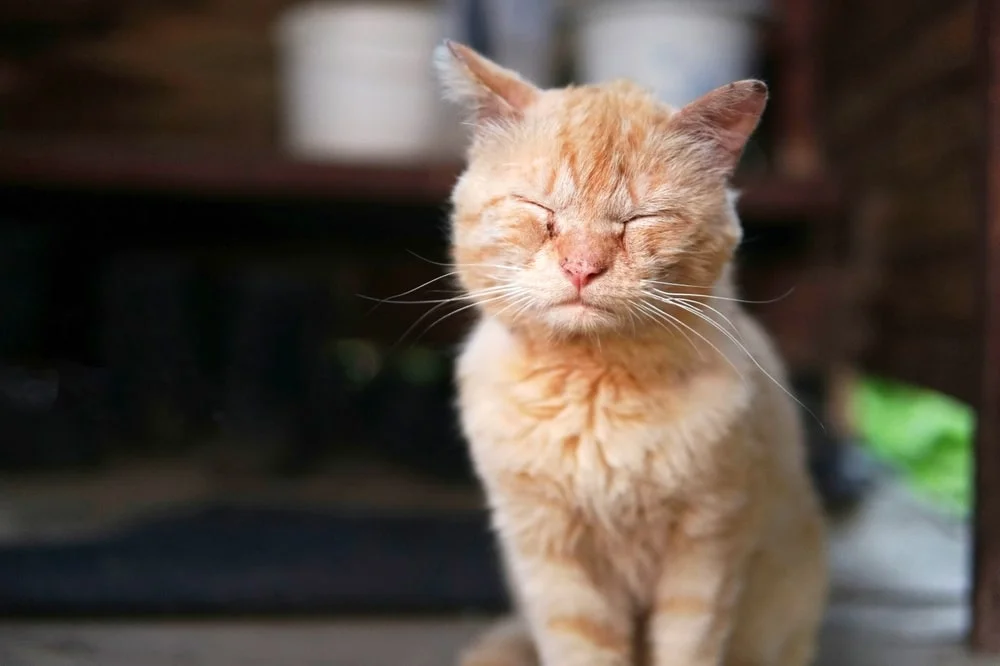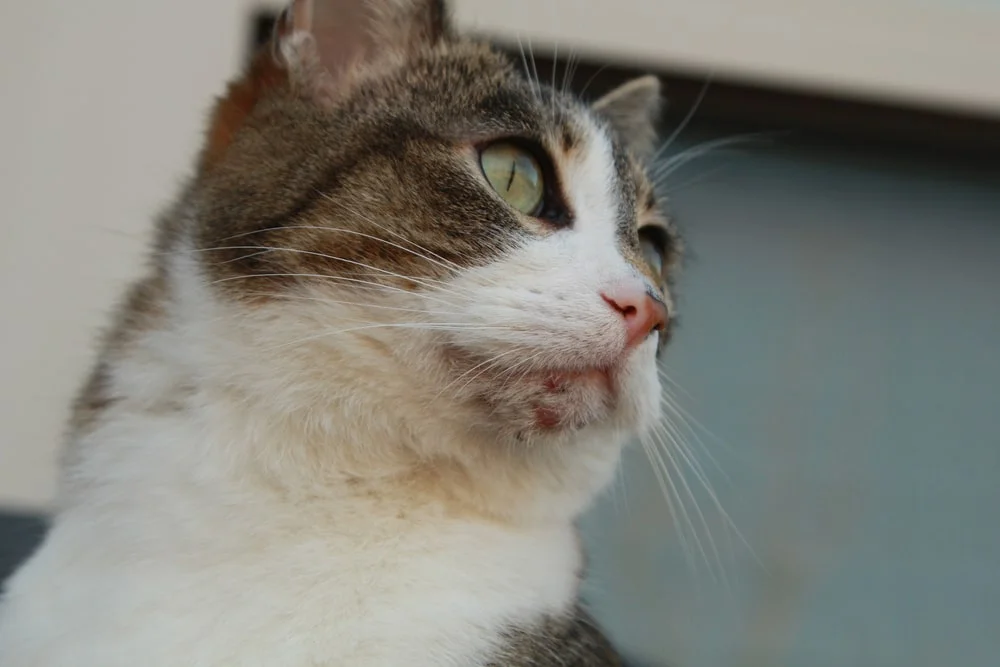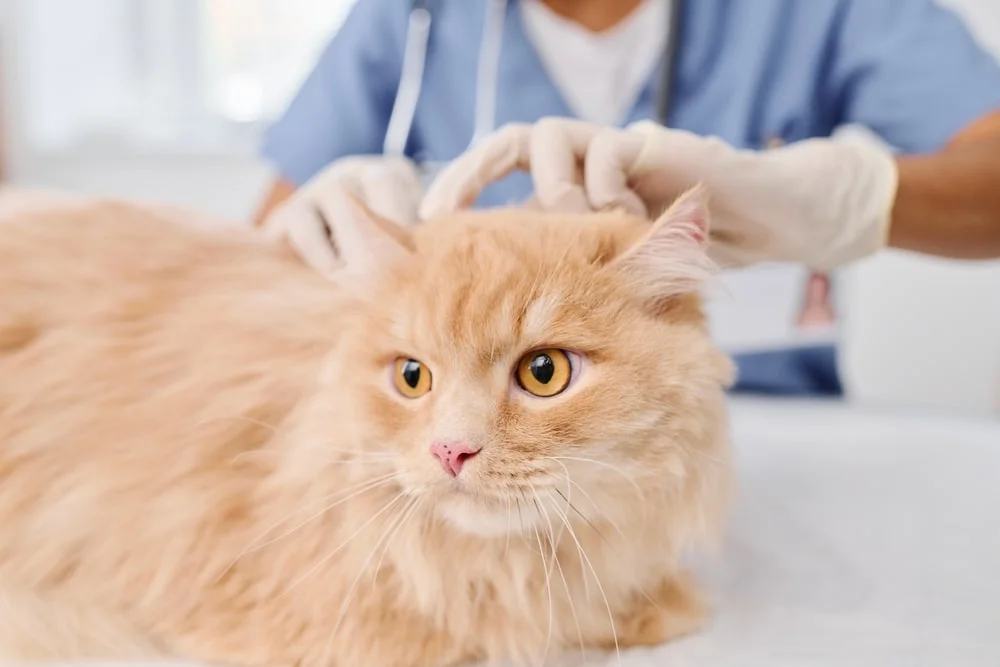There are hundreds of skin conditions that could affect a cat, and each of them has multiple symptoms.1 The best way to know what’s wrong is to take your kitty to the vet for a proper checkup. That said, here are some of the most common cat skin diseases and symptoms to look out for. We’ve also included cat skin condition treatments, so you’ll know what your next steps might look like.
1. Abscesses
Abscesses are open wounds that have been infected by bacteria. Something as simple as a scrape or graze could become an abscess if the wound isn’t properly treated. You’ll recognize them by redness and swelling around the wound, along with discharge of fluid and/or pus. Cats with abscesses may also change their behavior, becoming withdrawn or losing their appetite.
Remedies
An untreated infection could become a life-threatening problem over time. If your cat has an abscess, your first step should be to bring them to the vet. They should be able to clean the wound and prescribe topical medication and antibiotics. If necessary, your vet might also recommend surgery to close the wound.
Is a Costly Cat Itch a Concern?
2. Allergies
Environmental allergies are one of the most common causes of skin conditions in cats.2 Most cats tend to over-groom to deal with the discomfort caused by their allergies. This can lead to hair loss in patches around the areas most affected by their allergies.
Remedies
Identifying your cat’s allergies can be difficult, given the sheer number of potentially triggering substances they come into contact with each day. Pay close attention to your cat’s daily routine — where they go and what foods and other substances they interact with. You may be able to notice when they begin experiencing the effects of an allergic reaction. Your vet can also help you figure out what your cat may be allergic to and how to best treat it.
3. Alopecia
If you notice bald patches on your (normally furry) cat, they could be suffering from alopecia.1,2 The term is a general one, referring broadly to hair loss. To understand the root cause, you’ll need to bring your kitty to the vet. One of the most common causes of alopecia is stress.2 Cats often groom themselves in order to relax — and even more so if they’re experiencing excess stress.
Remedies
Identifying and removing the source of stress is the best way to deal with stress-induced alopecia. Of course, our cats can’t talk, so doing this will take some detective work. Your vet may be able to help you find out what’s got your kitty so anxious. In the meantime, calming pheromone sprays could help keep your cat calm.2
4. Ear Mites
Mites are considered a contagious cat skin condition. These tiny insects feed on dead skin and cause itchiness. Because they’re so itchy, cats with ear mites may scratch themselves enough to form scabs. Mites can also cause inflammation in the ears, which could lead to an infection if not treated.2 If you notice your cat doing some excessive scratching, particularly around their ears, it could be a sign of mites.
Remedies
Washing your cat’s ears can help relieve the itchiness of mites. It’s especially important to clean out their ears if you notice swelling or discharge — both signs of an infection.3 Your next step should be bringing your cat to the vet. They can recommend a good over-the-counter medication to treat your cat’s symptoms and eradicate the mites. In the meantime, be sure to keep your kitty away from other animals, so the mites don’t spread and reproduce.
5. Mange
Mange is an inflammatory cat skin condition caused by various mites.1,2 These microscopic insects bite and burrow into your cat’s skin, causing irritation, inflammation, and eventually hair loss. Your cat may also frequently scratch the affected areas, leading to scabs and even open sores.
Remedies
Topical treatments prescribed by your vet can quickly eradicate skin mites. Be sure to also thoroughly clean your kitty’s bed, collar, and any other surfaces or items they frequently come into contact with. It’s also important to keep your cat isolated from other animals during treatment to prevent the mites from spreading.
6. Endocrine Dermatosis
Endocrine dermatosis, also known as hormone responsive dermatosis, is caused by a hormonal imbalance.4 In some cats, it can lead to itchy dry skin, dandruff, and even hair loss. Other symptoms may include:5
- Brittle fur
- Dark spots on the skin
- Blackheads
- Inflammation of the outer ear
- Frequent urination
Remedies
Your vet will need to perform a number of tests to determine if endocrine dermatosis is behind your cat’s issues. This may include:5
- Reviewing their full medical history to rule out other causes
- A biochemical profile
- Blood tests
- Urinalysis
- Electrolyte panel
- Serum sex hormone test
- Skin biopsy
Treatment will vary depending on the type of hormone imbalance. For some cats, endocrine dermatosis is a lifelong condition that needs to be managed with prescription shampoos and topical medication.
7. Feline Acne
Just like humans, cats sometimes have to deal with the annoyance of acne. If you notice blackheads and swelling around your kitty’s chin and mouth, acne may be the likely culprit. Acne can be caused by an environmental allergy or contact with bacteria.
Remedies
One of the potential causes of feline acne is the use of a plastic food dish.6 In addition to irritating your cat’s chin, plastic food dishes also have porous surfaces, which can trap bacteria. The bacteria is then transferred to your kitty’s face, causing a secondary infection that results in acne. If this is the case, solving your cat’s acne could be as simple as replacing their plastic food and/or water dish with one made of glass or metal. Also, cleaning your cat’s face and fur with cat-safe wet wipes can help prevent and alleviate acne. Consult your vet for a conclusive diagnosis and more treatment options.
8. Miliary Dermatitis
Among the many symptoms of cat skin conditions, scabs are perhaps the most common. Miliary dermatitis refers to clusters of scabs caused by an allergic reaction to flea bites.2 Fleas are another tiny insect that prove bothersome to many cats. Severe cases can cause excessive blood loss, a condition known as anemia.7
Remedies
Flea prevention is one of the most important steps you can take to keep your kitty happy and healthy. Flea collars and topical ointments are common preventive steps. If your cat already has a case of fleas, isolate them from other animals to prevent spreading the critters. Your vet may recommend specialized shampoo to use daily, as well as medication that turns your cat’s blood lethal to fleas. In the meantime, thoroughly clean your entire living space — especially areas your cat frequents — to eliminate the infestation once and for all.
Does Pet Insurance Help With Skin Conditions?
With so many possible cat skin conditions, it may seem like only a matter of time before your kitty comes down with something. Diagnosis and treatment can become expensive, especially if multiple tests and medications are required. Fortunately, a cat insurance policy from MetLife Pet could reimburse you for up to 90% of the cost.8 Our optional Preventative Care add-on can also help cover the cost of flea prevention and other important measures.
Learn more about the importance of pet insurance, and then get a free quote to find out how much you could save while keeping your cat’s skin healthy!
Skin Conditions May Hurt Your Cat and Your Wallet. Pet Insurance Can Help.
**As with any insurance policy, coverage may vary. Review our coverage and exclusions.
1 “Cat Skin Conditions: Dry Skin, Skin Allergies, Skin Cancer, Itchy Skin & More,” PetMD, 2021
2 “11 Most Common Cat Skin Problems,” Animal Trust
3 “Ear Cleaning and Administering Ear Medication in Cats,” VCA Animal Hospitals
4 “Introduction to Hormonal Disorders of Cats,” Merck Veterinary Manual, 2022
5 “Baldness and Hormone-Related Skin Disorders in Cats,” PetMD
6 “Chin Acne in Cats,” VCA Animal Hospitals
7 “Flea Control in Cats,” VCA Animal Hospitals
8 Reimbursement options include: 70%, 80% and 90% and a 50% option for MetGen policies and a 65% option for IAIC policies only. Pet age restrictions may apply.
Coverage issued by Metropolitan General Insurance Company (“MetGen”), a Rhode Island insurance company, headquartered at 700 Quaker Lane, Warwick, RI 02886, and Independence American Insurance Company (“IAIC”), a Delaware insurance company, headquartered at 11333 N Scottsdale Rd, Ste 160, Scottsdale, AZ 85454. Coverage subject to restrictions, exclusions and limitations and application is subject to underwriting. See policy or contact MetLife Pet Insurance Solutions LLC (“MetLife Pet”) for details. MetLife Pet is the policy administrator. It may operate under an alternate or fictitious name in certain jurisdictions, including MetLife Pet Insurance Services LLC (New York and Minnesota) and MetLife Pet Insurance Solutions Agency LLC (Illinois).
Disclosure for Maine Residents
L0124037313[exp0125][All States][DC,GU,MP,PR,VI]




